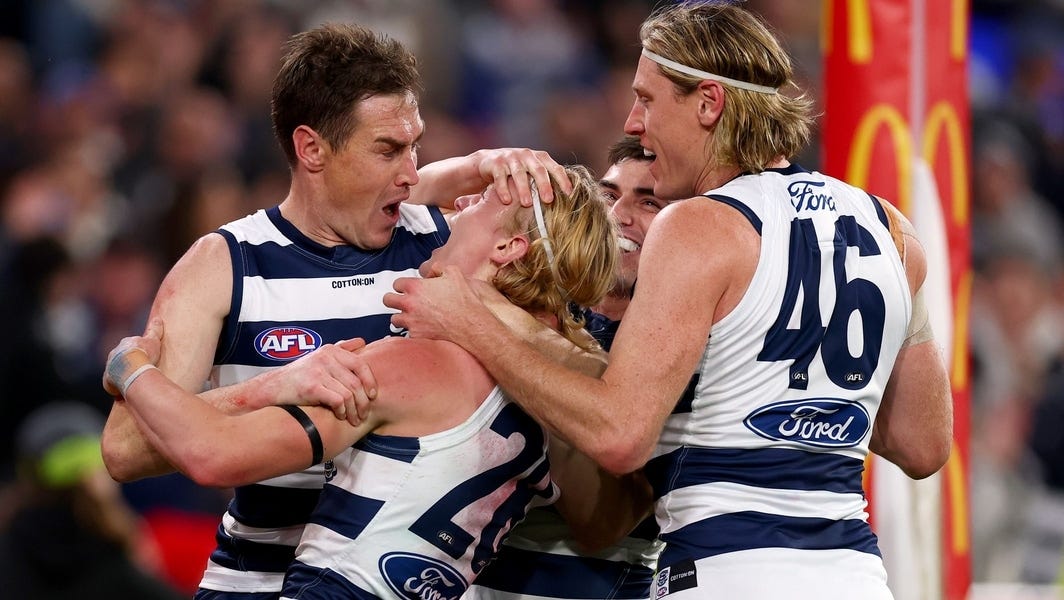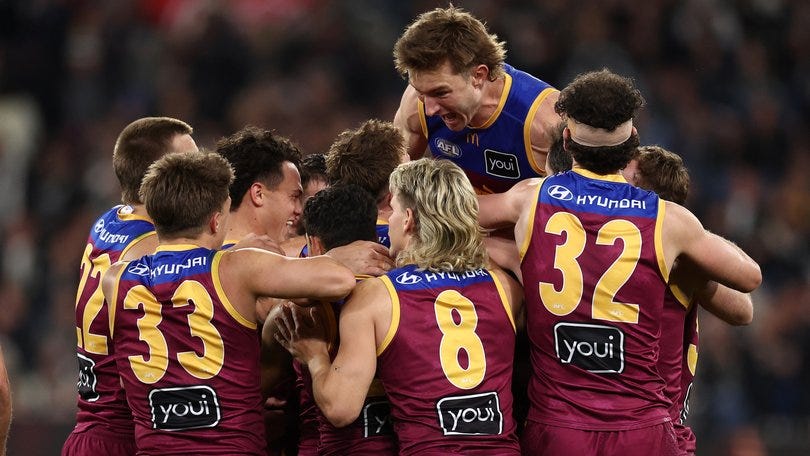2025 Grand Final preview
Footy is a funny game; 46 men run around for two hours and, at the end of it, Geelong and Brisbane play in the decider.
After 215 games, it’s an all-feline Grand Final. As well it should be. Even beyond their prowess this season, Geelong and Brisbane (with apologies to Collingwood and Melbourne fans) have been the most successful clubs of this half-decade. Only Brisbane boasts more wins (102) in the 2020s than Geelong (97). It’s a long way down to Port (86) in third place. And only Geelong, Brisbane, and the Western Bulldogs have won at least 10 games in every season this decade. The Cats and the Lions have stalked each other in recent years: they squared off in Preliminary Finals in 2022 and 2024, with the winner of each going on to lift the cup. Saturday, then, assumes a greater significance than “just” the Premiership: the winner will stand alone, legacy secured, as the dominant side of the immediate post-Covid era.
Despite their twinned destinies, these clubs have taken different paths to the big dance. Geelong, after an indifferent first month of the season which, in hindsight, feels a lot like ironing out some kinks, have stormed home, winning their last eight games by an average margin of 51.75 points. Brisbane have again opted for the scenic route. There have been some perplexing results – none more so than an 11-goal reverse to Gold Coast and an artificially close two-point home loss to Sydney. But, at the risk of assigning a narrative where it might not be warranted, the 2025 Lions have always felt like a side in control – one that knows how and when to lift their level. Spells of diffidence punctuated by supreme displays of power; I can think of no better analogy than to the animal which gives Brisbane its nickname.
I wrote last year that both Grand Finallists were seeking redemption. That isn’t the case this year. By beating Sydney as comprehensively as they did in 2024 and returning to the last Saturday of September this year despite the loss of Joe Daniher, Brisbane have shown they’re here to stay. They have completed modern footy’s greatest rebuild. Given the quality of their young core, the fecundity of their academy, and their attractiveness as a destination for free agents, it seems certain they will stay at the top for years to come. The Cats, meanwhile, just keep doing it. Their list and game plan bear the scantest of resemblance to 2020. Today, they are the model of the ultra-fast transition side that so troubled them during Richmond’s run. But no side is better at adapting to footy’s changing demands, turning duds into diamonds, and ruthlessly exploiting their opposition’s soft points. Geelong have been footy’s apex predator for almost 20 years, and at this rate, it looks like that’s what they’ll be until the heat death of the universe. So this doesn’t feel like either side’s last chance at Premiership glory for a while; instead, it feels like another instance of their mastery of the modern game.
The scene has been adequately set. Let’s get into it.
Last time they met
Geelong 16.16 (112) def. Brisbane 11.8 (74)
Heading into this year’s Qualifying Final, the Lions had won the last three games against Geelong, including most recently at GMHBA Stadium (even if a 41-point win masked what, in truth, was an even game). They play arguably their best footy at the MCG. Chris Fagan and his players would have felt confident. So being thoroughly outplayed, to the tune of 38 points, would have felt a little like going down the slide at the Big Freeze.
The genesis of Geelong’s dominance that day, somewhat uncharacteristically given the “typical” profiles of both sides, was stoppages. Max Holmes broke lines, and the stopping power of Tom Atkins and Oisin Mullin meant the Lions’ prime movers couldn’t do the same (Lachie Neale being underdone/still injured also helped). The Cats scored 50 of their 112 points from stoppages, including 21 points directly from centre bounce. When they weren’t scoring from them, Geelong were effective at turning stoppage wins into sustained territorial gains – more than 60 per cent of their game was played in their forward half – which yielded opportunities to create and exploit turnovers. Only one side all year has scored more points against Brisbane from forward-half chains than the 61 Geelong did in the Qualifying Final (a bonus point for the reader who tells me which side it was).
Describing statistics isn’t quite the same as explaining what happened – so how did Geelong do it? I saw two clear tactical wins that Chris Fagan will need to address if he’s to avoid the same result this Saturday. The first was Oisin Mullin’s suffocating tag on Hugh McCluggage. McCluggage’s ability to go from inside to outside, as well as his exquisite kicking, makes him an extremely important component of Brisbane’s expansive ball movement scheme. Chris Scott understood that and instructed his Irishman (everyone needs an Irishman) to not let McCluggage out of his sight. In case this sounds like an unconditional argument in favour of tagging, it isn’t. The costs and benefits are always situational. What made it a good choice in this particular game was Lachie Neale being physically underdone and thus not able to cause enough damage to cause Scott to reconsider how he allocated his defensive midfield players. With Neale’s fitness the major media-driven talking point (you gotta have a storyline!) ahead of Saturday, Fagan will need McCluggage to perform at the level he has been for most of his All-Australian season. He’s apparently been working on how to break a tag.
The other, closely related facet of Geelong’s superiority three weeks ago was their ability to win the aerial battle. As is well known by now, Brisbane rely on marks both to initiate attacking chains and also to control the tempo and defend with the ball. They’ve only taken fewer than the 90 marks they managed in the Qualifying Final four times in 2025. And a -10 mark differential was the third-worst return for the season. The Lions have only taken fewer marks than their opposition in four games this season. They’ve lost three of them. So the fact that Geelong were able to repeatedly break the lines to create outnumbers and overloads when they had the ball, and deny Brisbane their preferred kicking and leading lanes (partly by depriving McCluggage of clean access), especially in the back half, was a significant reason for their success. The Qualifying Final adds another layer of intrigue to Saturday’s game. The onus will be on Chris Fagan, who is usually regarded as a coach who is happy to establish a style and process and allow his players solve problems themselves, and his coaches to come up with a solution to the problems Geelong presented.
Why Geelong will win
Some things to consider before getting into the meatier stuff: Geelong have played one fewer game – a meaningful difference in what’s become a very long season. None of their stars are under an injury cloud (although Tom Stewart, despite being a slightly diminished figure in 2025, is still a big out). Patrick Dangerfield is coming off one of the best games of his storied career. Their average winning margin across the whole season is almost eight goals. They haven’t lost a game since the second week of July, in a competition where form on the day is literally the whole ball game.
But I think the most important factor which makes Geelong, at least in my eyes, slight favourites, is this: their combination of strengths – fast transition (especially by their players carrying the ball), capacity to win one-on-one contests forward of centre, and ability to nullify strong clearance midfields – makes Brisbane uncomfortable.
I want to start with the last of those points first. Since you’re reading this, you’re probably familiar with the idea that clearances have never been more weakly correlated with winning games of footy. Post-clearance, much like post-rock in the 2000s, has swooped in to steal its less modish older sibling’s lunch. Brisbane are excellent at generating clearances (a byproduct of having approximately one thousand good midfielders). This season, the Lions ranked fourth in the AFL for first possession in stoppages, second in translating those first possessions to clearances, and second in overall clearance differential. Geelong were below league-average in both metrics. But only the Dogs are better than the Cats when it comes to scores from stoppage differential – almost two goals a game better than the Lions. It’s not a paradox. It’s a function of Geelong’s structure at stoppages. They are comfortable with letting their opponent lead them to the ball. They are, in some cases, not even that fussed about losing the clearance. That’s because they trust their ability to either turn the ball over while it’s still inside the stoppage – say, via a Tom Atkins tackle and subsequent Geelong gather – or after it’s come out (via a Tom Stewart/Jack Henry/Connor O’Sullivan intercept mark). The Cats will then look to rapidly exploit that moment the opposition is out of defensive structure to get the ball forward into one-on-one situations. That ability to work around not getting first hands on the ball is what makes Geelong a complete side than the teams who rely on winning clearances to move the ball. Brisbane aren’t that team. But they still suffer, at least a little, against good defensive midfields.
I wrote in my season preview that Geelong are the fastest side in the AFL at moving the ball towards the opposition goal. That was before Bailey Smith had even played a game for them. To put it as simply as possible: Geelong move the ball faster than any other side because they have very fast guys who run all day and kick it long to teammates who are extremely good at retaining possession. The stuff that makes it actually function as well as it does is slightly more nuanced – the way Geelong’s half-forwards rotate and create space for each other, the way they generate overlap run from the defensive midfield area, Gryan Miers’ ability to find a teammate inside 50 – but the basic truth is as I described it. Geelong overwhelm sides because their combination of athleticism, power and precision is a very difficult combination to beat. Max Holmes is fast (and skilful). Bailey Smith is fast (and, although not quite as skilful, still pretty skilful). Dangerfield is astonishingly fast for a guy his age, and as tough as ever.
Geelong’s speed in possession, including their willingness to run with the ball (they ranked eighth for bounces, Brisbane 18th) is what enables them to consistently create advantageous situations ahead of the ball. Almost every time Jeremy Cameron takes an uncontested mark, or Ollie Dempsey sits on some poor unsuspecting chap’s head, or Gryan Miers/Shaun Mannagh/Brad Close finds themselves in Geelong farmland-esque expanses of space, it’s downstream of a Geelong player winning an important contest or breaking a line higher up the field. If you gain clear possession from a disputed situation, and advance the ball quickly enough, no defence will have time to set itself properly. That’s what Geelong do, better than anyone (they’re first in the AFL for turnover differential) – and it’s what, for the reasons I described above, they did to Brisbane just three weeks ago. I have no doubt Brisbane’s coaches will have analysed that game and worked hard on a counter – but it feels like they’re beginning from behind the eight-ball.
Why Brisbane will win
Before I dive deeper, here’s the corresponding list of reasons Brisbane fans should feel confident of victory on Saturday: firstly, they’re the reigning champs. Been there, done that, got the t-shirt, etc. Secondly, they have always lifted their level when they’ve really had to. Thirdly, they learn their lessons. Brisbane’s heaviest defeats of the season so far have been to Collingwood (by 52 points in Round 6) and Gold Coast (66 points, Round 20). Brisbane won their next two games against Collingwood, one of which was of course the prelim, by 27 and 29 points. And they dispatched the Suns by 53 points in the Semi Final. 119 points is a handy turnaround.
Paradoxically, the thing that makes Brisbane such good learners is their refusal to deviate from their style. There are few more enduring shibboleths in footy than the “Plan B” – the idea that a coach should simply flick a switch and instruct their players to play a totally different style to the one they’ve spent months, perhaps even years, drilling. Of course, there are dozens of small tactical levers that coaching teams pull across and within games – subtle variations on how to deny space to dangerous opposition players, how to set up at stoppages, how frequently to use the 45 kick from half-back, et cetera. But there isn’t a big lever with Plan B written on it. The costs of switching to a different style are too high in the thin margins of the AFL. That’s especially true for Fagan’s Lions. Theirs is the most distinctive style in modern footy. Consider this:
This is the profile of a side that plays a very particular way: moving the ball upfield by foot, undaunted by difficult kicks, protecting with marks, and using stoppages (ruck contests are effectively a measure of stoppages per game) to create neutral situations to exploit. Brisbane have the highest “control ratio” – the ratio between their marks and ground balls – in the AFL (Geelong are second). The Lions are footy’s constant (Darcy?) gardeners, patiently plowing their furrows regardless of what the opposition presents them with. The Lions can lose. But they almost never look flustered. Despite the differences in speed and broadness of tactical approach I’ve already spoken about, the side whose profile is closest to Brisbane’s is… Geelong. The Cats also rank right at the very top of the pops for kicks, marks, and kicks as a share of disposals. But, perhaps because Chris Scott has made them so flexible, so adaptable to the strengths of their opponents, they’re perhaps not quite as well-honed in this style as the Lions. Brisbane’s style is second nature – and it’s a big reason why their level virtually never dips in the most important games. Most sides would be apprehensive about a rematch against the side that beat them by six goals in a Qualifying Final. I doubt Brisbane will be.
All that being said, there are specific quirks to the way the Cats play which Fagan will believe he can exploit. The results of Geelong’s games are highly sensitive to the results of aerial contests. In the games they’ve won in 2025, the Cats have taken an average of 19.47 more marks than their opposition. In their losses, that flipped almost totally – Geelong’s opponents took 18 more marks. What happens in the Cats’ forward half is especially important: in their wins, they average 58.9 points from forward half chains, compared to just 35.3 when they lose. “Teams score more points when they win and fewer when they lose” won’t win any prizes for analysis, but I think there’s something to it – the way Geelong create pressing traps, block their opponents’ outlets in the back half, and halve or win aerial contests, is exemplary. Brisbane didn’t quite get that risk/reward balance right in their previous encounter. But Chris Scott’s choice to apply a hard tag to Hugh McCluggage might have shown his ace a game too soon. If – and it is an if – Brisbane can work around it, perhaps by shifting more of the responsibility to advance the ball to another player (say, the way Darcy Wilmot did against Collingwood in the prelim), then they can reassert their style which is so hard to stop on the wide expanses of the MCG. In games this season, Geelong’s opponents have averaged almost exactly the same from scores from stoppages, irrespective of the result – a tick under 30 points. It’s teams’ ability to punish the Cats on turnover that makes the difference. In games Geelong lose, their opponents average 48.2 points from turnovers, almost three goals more than in games the Cats win. All the Lions need is a subtle recalibration.
Enjoying my Grand Final preview? Please consider sharing it with a mate!
Five questions that matter
Can Brisbane find a way to reassert their control game?
Will Lachie Neale be fit?
How will Chris Scott replace Tom Stewart’s intercepting?
Can Brisbane halve enough contests inside their forward 50?
Can Geelong generate enough advantageous aerial contests forward of centre?
Who will win?
Geelong presented Brisbane with enough problems in their Qualifying Final that, especially if Lachie Neale is less than fully fit, I’m not sure the Lions can quite solve. The Cats – but only by a little. It should be a classic.
Final word
If you harbour a particular dislike for these teams, I’ve got bad news: they’re not going anywhere. In some obvious ways, they are very different. Brisbane are enjoying the rich fruits gathered from years wandering the wilderness, while the word “rebuild” may as well be written in Proto-Elamite in Geelong. The Cats go (very) fast, while the Lions are more measured. The Lions look to play the same way regardless of their opposition, whereas Geelong under Chris Scott present bespoke problems. But it’s also possible to discern similarities to how these sides, and the clubs they represent, have found their success. Both assert their superiority by controlling the ball. Both have prolonged their time at the top by offering a unique value proposition to trade and free agency targets. And both set the standards in the modern AFL. Other sides fall off cliffs or never climb them in the first place. Not these two.







Congrats to the Lions
https://preceperi.substack.com/p/videbo-felix-vici?utm_source=share&utm_medium=android&r=5h1r4j